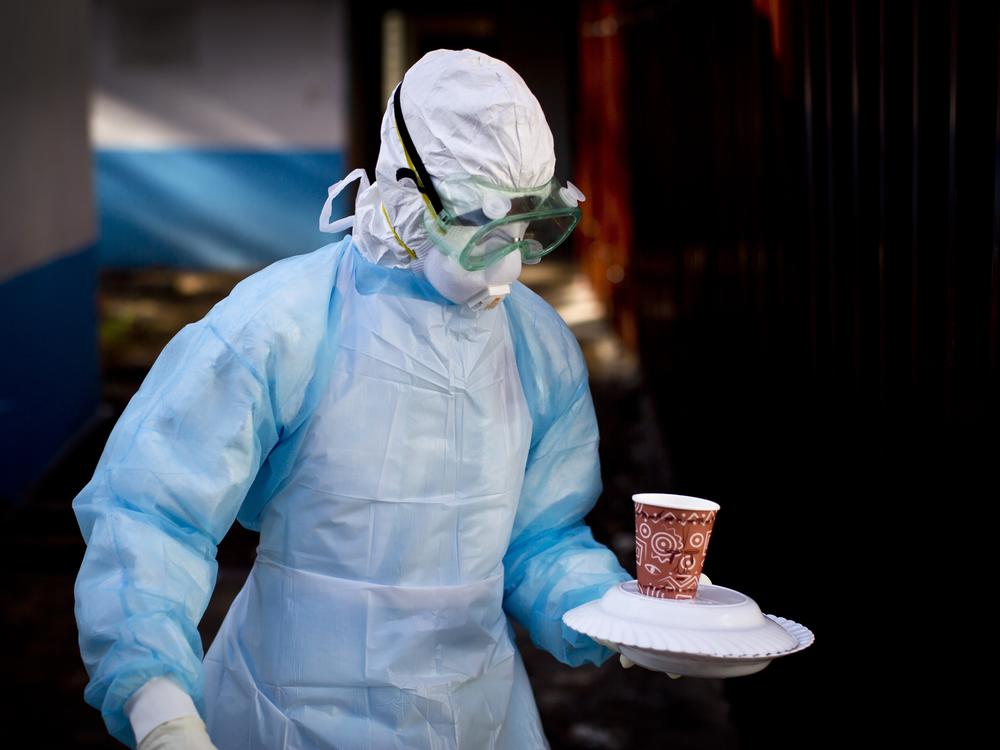Section Branding
Header Content
Marburg is an especially scary virus. How scared should we be of Rwanda's outbreak?
Primary Content
“Do not continue your daily activities” if you have a high fever, a severe headache, diarrhea or vomiting, urged Sabin Nsanzimana in a press conference this weekend.
If you are healthy, live life as normal and do "not panic," he said. But those feeling sick must seek immediate medical attention.
Nsanzimana is Rwanda's health minister — and his country is in the grips of its first-ever outbreak of the deadly Marburg virus.
The virus comes from fruit bats and is in the same family as the Ebola virus. There are no known treatments or vaccines, although supportive care like IV fluids is helpful. The death rate can be as high as 88%.
With more than 27 cases so far — and nine deaths — this outbreak is already the fourth largest Marburg outbreak ever recorded. The World Health Organization has deemed the “risk of this outbreak as very high at the national level, high at the regional level and low at the global level.”
Jennifer McQuiston is the deputy director of the division at the U.S. Centers for Disease Control and Prevention that studies lethal viral diseases. She says whenever she hears about patients showing up with symptoms like a high fever and blood in vomit or stool, it sets off alarm bells in her mind. A whole host of serious viruses can cause what’s called a viral hemorrhagic fever — think Ebola and yellow fever.
“When this was confirmed as Marburg, it solidified those concerns,” she says.
There are a number of factors, she and other experts say, that make this outbreak particularly concerning. But there’s also a silver lining and a bit of reassuring news.
A lot of cases all at once
McQuiston says one of the first things that caught her attention is just how many Marburg patients there were — more than two dozen — when the outbreak was first announced by Rwandan health authorities on Friday.
“We're concerned about the number of cases that got diagnosed very quickly,” she says, noting that it can take as long as 21 days between exposure and the onset of symptoms. “That indicates to us it's probably been circulating for a few weeks.”
This could have happened because Rwanda has never reported Marburg cases before, which would mean that health care professionals weren’t initially thinking about testing patients for it. That’s likely because many of the symptoms — like a high fever — can easily be caused by other ailments.
“Knowing what's happening is the first important step so you can put in the right prevention measures,” McQuiston says. “That is happening now.” Medical professional are advised put on impermeable gowns, respirators and double gloves when dealing with a possible Marburg patient and Rwandan officials have set up handwashing facilities so the public can help prevent the virus from spreading further.
The other worry with the high number of cases is that the virus “might have had time to spread in ways they haven't even begun to understand yet,” says McQuiston. In past outbreaks, the virus comes from a bat likely through contact with their urine or other excretions — or from eating the same fruit that an infected bat nibbled, for example.
But a few of the past outbreaks didn't have a clear bat link, so there’s speculation that there could be an intermediate host — for example, a bat gives the virus to a monkey or pig who then passes it on to a human who consumes the meat. And a person who's infected can spread the virus to another person. However, past outbreaks have been relatively small, in part because patients die so quickly and the virus does not transmit through the air.
Health care workers are hard hit
A second major reason for concern is that 70% of the Marburg patients in Rwanda, so far, are health-care workers.
Since the virus can spread from person to person through contact with bodily fluids — blood, vomit, stool, saliva and even semen, for example — McQuiston’s guess is that missing the initial diagnosis meant the health-care workers in the past few weeks were likely caring for one or more Marburg-stricken individuals but didn’t suit up in protective gear.
Now Rwandan officials are taking action. They’ve identified and are monitoring about 300 contacts of Marburg patients to see if they’ve contracted the virus. Their response has drawn praise — and some questions.
Dr. Abraar Karan, an infectious disease postdoctoral researcher at Stanford University, says that when he heard Rwandan health officials tell people with symptoms to go to their nearest health center, he found it a “risky” approach. He worries that patients might take public transit, putting others in danger — and showing up at a hospital waiting room could put other patients and clinical staff at risk of exposure until a diagnosis is confirmed.
Instead, Karan says, “it would be important for community health workers to ... get ... to people's homes.” That way they can wear protective gear when collecting samples for testing and help arrange transport to a unit designated specifically for Marburg patients, he says.
It’s in the capital
The Marburg virus — which is named for the city in Germany where scientists first became ill with the disease in 1967 when handling monkeys from Africa — is typically found in Egyptian fruit bats who live deep in caves. Cases usually occur in remote areas — someone might go into a cave as a miner or to collect bat guano to use as fertilizer and get exposed to the virus.
But cases in this outbreak aren't confined to a remote area. Instead, patients have been identified in seven of Rwanda’s 30 districts — and is in the capital city of Kigali.
Karan says the worry is that through human transmission, the virus could quickly spread onward to other places. “It's already hit a hub, a transportation hub,” he says. “You have a lot more movement between countries and between continents.” It’s easy for someone who has been exposed but is not yet symptomatic to jump on a bus or plane without realizing they are carrying the virus.
Indeed, WHO confirmed in a statement that at least one person who was in contact with a Marburg patient has already traveled — to Belgium. The statement said “appropriate response measures have been implemented.”
Rwandan officials are already doing contact tracing and have called for limiting attendance at funerals for Marburg patients to 50 people. This restriction echoes the Ebola crisis, when family members who cleaned the body or had other physical contact with the corpse were at risk of exposure to virus-laden bodily fluids.
The U.S. is having embassy staff in Rwanda work remotely and alerting physicians domestically about the situation. In the West African Ebola outbreak, 11 people in the U.S. were treated for the virus, most of whom caught the virus while abroad.
“Rwanda is a place where a lot of United States health-care workers and clinicians go to provide aid or do mission trips. And so I think tracking who's been over there and making sure that they are monitoring their health when they come back, is an important thing that we're actively doing right now,” says the CDC’s McQuiston.
An opportunity for progress
The lack of vaccines and treatments designed specifically to help Marburg patients is a major challenge, but outbreaks can offer opportunities for testing.
“With Marburg it's very hard to study the vaccines without cases. And so in a setting like this, you may be able to deploy the vaccines and figure out vaccine effectiveness,” says Karan.
There are Marburg vaccines in Phase I and II development. McQuiston says there are active discussions about whether vaccines could be tested in this outbreak. Joachim Hombach, executive secretary of WHO’s Strategic Advisory Group of Experts on Immunization, says, if this outbreak is going to be used for a vaccine study preparations would have to “move very fast.”
And though infectious disease experts are worried, they say they feel some reassurance because of Rwanda's robust health care system.
“We believe that Rwanda has the capacity and the ability to stop this outbreak very quickly,” says Brian Chirombo, the World Health Organization’s representative to Rwanda.
But McQuiston admits that Rwanda’s health system is juggling a lot, with an ongoing mpox outbreak as well. “Our [CDC] staff are stretched quite thin as we think about, ‘How do we mount dual responses?’ And I can only imagine that in Rwanda — where both of these outbreaks are occurring, but they also have malaria and a lot of other health concerns — that it creates a situation that, I think, stresses their health systems,” she says.
Karan says it will likely take several weeks before it’s clear where this outbreak is heading.
“We've seen other Marburg outbreaks have been small and, then, got under control,” Karan says. “I hope that's what happens.”


